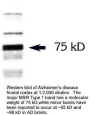Macrophage scavenger receptors (MSR) are membrane
glycoproteins that mediate the recognition and uptake of a wide variety of
negatively charged macromolecules. There
are two types of these receptors that differ in the C-terminal region.
MSR has a key role in scavenging a variety of macromolecules,
including modified lipoproteins, advanced glycation end (AGEs) products
and amyloid b-protein
(Ab).
While the normal role of MSR is associated with cell adhesion and
host defense mechanisms, it also has been implicated in the development of
atherosclerosis and Ab
deposition in Alzheimer’s disease (AD).
The observation that the ,4
allele of the apolipoprotein E gene is associated with an increased risk
for AD has lead to the investigation of lipoprotein metabolism in the
brain of AD patients. The type I MSR has been found to be expressed on
microglia and Mato cells, but not astrocytes or neurons.
In AD brain, MSR type I is strongly expressed by microglia cells
that are associated with senile plaques.
Because the senile plaques contain AGEs, which are a source of free
radicals that could result in oxidative damage to the brain, MSR may have
a role in mediating the endocytosis of AGEs.
A goat antiserum to a synthetic peptide that
corresponds to amino acids 325-342 of the C-terminus of the human MSR is
currently available. This antiserum has been shown to be immunoreactive
with the unconjugated immunizing peptide by ELISA. The antiserum has been
shown to be immunoreactive with amyloid plaques in formalin-fixed,
paraffin-embedded sections of AD brain.
This antiserum is suitable for western blots and recognizes the MSR
protein. This antibody should be a valuable tool for scientists working to
understand the role of MSR in AD.
antiserum has been shown to be immunoreactive
with the unconjugated immunizing peptide by ELISA. The antiserum has been
shown to be immunoreactive with amyloid plaques in formalin-fixed,
paraffin-embedded sections of AD brain.
This antiserum is suitable for western blots and recognizes the MSR
protein. This antibody should be a valuable tool for scientists working to
understand the role of MSR in AD.
 This
antiserum was produced using proprietary methodology whereby the peptide
is attached to a carrier that elicits minimal immunoreactivity so that the
antiserum has a higher degree of specificity for the peptide.
Since there is no overwhelming production of interfering antibodies
to the carrier, this antiserum can routinely be used without further
purification. Pseud-Immune™ control
immune serum (Cat no. GPA018E) from a mock immunized animal is available
to be used in conjunction with this antibody as well as the immunizing
peptide (Cat no. HSP015C), which can be used to neutralize
immunoreactivity.
This
antiserum was produced using proprietary methodology whereby the peptide
is attached to a carrier that elicits minimal immunoreactivity so that the
antiserum has a higher degree of specificity for the peptide.
Since there is no overwhelming production of interfering antibodies
to the carrier, this antiserum can routinely be used without further
purification. Pseud-Immune™ control
immune serum (Cat no. GPA018E) from a mock immunized animal is available
to be used in conjunction with this antibody as well as the immunizing
peptide (Cat no. HSP015C), which can be used to neutralize
immunoreactivity.
Manufacturing
Reference:
Makato, N., et al.
Am. J. Pathol. 141:591-599, 1992.
 Polyclonal Anti-human
Polyclonal Anti-human